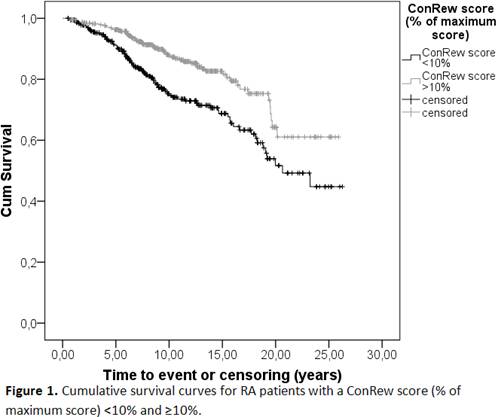Session Information
Session Type: Abstract Submissions (ACR)
Background/Purpose: Chronic inflammation appears to be an independent risk factor for CVD in rheumatoid arthritis (RA), but there is no clear difference in CVD risk between RA patients with low or high disease activity (1;2). Possibly, only if disease activity is very low (‘remission’) it may protect against CVD. The objective of this study was to investigate the association between clinical remission (DAS28<2.6) and the risk of CVD in patients with RA.
Methods: RA patients from the Nijmegen inception cohort were selected if they had at least one year follow-up. Patients were seen at 3-month intervals and the DAS28 was assessed at each visit. Cardiovascular events included myocardial infarction (MI) and stroke, transient ischemic attack, angina pectoris and peripheral arterial disease. Remission was defined as DAS28<2.6. A continuity rewarded score (ConRew) was calculated: a score of 1 was rewarded if DAS28<2.6 and a score of 2 was rewarded if DAS28<2.6 at the previous visit too. The ConRew score was divided by the maximal possible score (100% if always in remission) and this was used in the analysis. The crude data were analysed using Kaplan-Meier survival analysis, divided in two groups according to the median of the ConRew ratio. The risk of CVD in RA patients was analysed using a Cox-proportional hazard model, with ConRew ratio as the independent variable, and time to CVD event as the dependent variable. Considered confounders were age, gender, prior CVD, rheumatoid factor (RF), anti-CCP and DAS28, HAQ, medication for CVD prevention, glucocorticosteroid use, cholesterol levels and systolic blood pressure at baseline. Missing values were imputed using multiple imputation, results of the analysis are based on the pooled data.
Results: A total of 770 RA patients were selected for analysis. Patients had a mean±SD age of 56±13 at baseline, 61% female, 76% RF positive with a mean±SD DAS28 at baseline of 5.1±1.4. In total, 153 CV events were registered. Age, gender, prior CV event, and TC:HDL ratio, medication for CV prevention, HAQ and DAS28 at baseline were included as confounders. Results from the Kaplan-Meier survival analysis in the crude data (figure 1) showed that patients who were less in remission, maximum ConRew score <10%, were more likely to develop CVD than patients who scored ≥ 10%, (p<0.001). In the Cox proportional hazards model, it was shown that a higher ConRew score had a protective effect for developing CVD (OR 0.48 [95% CI 0.66-0.83]), corrected for confounders.
Conclusion: Sustained remission in patients with RA is significantly associated with a reduced excess risk of CVD. Maintaining tight control of disease activity in RA patients to achieve remission is therefore important for the prevention of CVD events.
References
1Radovits et al. Ann Rheum Dis. 2009;68:1271-76.
2Arts et al. [abstract]Arthritis Rheum. 2011;63(supplement 10):2585
Disclosure:
E. E. A. Arts,
None;
J. Fransen,
None;
A. A. den Broeder,
None;
C. Popa,
None;
P. L. C. M. van Riel,
None.
« Back to 2012 ACR/ARHP Annual Meeting
ACR Meeting Abstracts - https://acrabstracts.org/abstract/sustained-clinical-remission-disease-activity-score-28/

